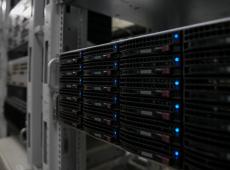The Fire, Fuel, and Smoke Science Program (FFS) advances the state of the science related to modeling important processes on the landscape. Advanced computing facilities at the Missoula Fire Sciences Lab provide the mission-critical capacity to expand the frontiers of fire spread, fire danger, and air quality modeling.
As a science organization, we are continually asking questions which demand more of the tools we use to find answers. High-performance computer systems are the tools we use when pursuing the answers to particularly demanding questions.
The Missoula Fire Sciences Laboratory has two types of high-performance computing systems: a symmetric multiprocessor (SMP) computer and a distributed memory computer cluster (also referred to as a Beowulf cluster). Both of these computer systems provide means to coordinate work on a single problem by multiple processors. An SMP computer makes all information about a problem available to every processor, while in a Beowulf cluster a single processor only has information relevant to a small piece of information about a problem at one time. A Beowulf cluster tends to be less expensive than an SMP computer with a similar number of processors, but an SMP computer can tackle problems that require a more cooperative and less independent approach to a solution.
The Fire, Fuel, and Smoke Science Program relies on high-performance computing systems as essential tools for research. In the past, the Program provided real-time air quality forecasts for the western United States. Currently, real and hypothetical fire situations are simulated to support fire operations. Historical and predicted climate impacts on biomass burning are generated using the ORCHIDEE model. The succession of plant species after fire is examined using FireBGC. The Fire Dynamics Simulator, and it’s cousin the Wildland Fire Dynamics Simulator, supports probing of the underlying physics related to buoyant flames, convective heating, and radiant heating. These cross-cutting research areas are all supported by the ability to run numerically intensive simulations on large domains.
